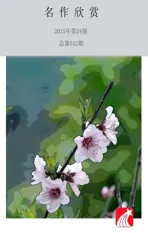文字、文学、文化:《桃花源记》六个英译本比较
2013-08-15尹衍桐中国石油大学华东文学院山东青岛266555
⊙尹衍桐[中国石油大学(华东)文学院, 山东 青岛 266555]
陶渊明的《桃花源记》以武陵渔人进出桃花源的行踪为线索,以发现桃源、做客桃源、离开桃源、再寻桃源的情节,描绘了一个理想的桃源世界,深受人们喜爱。这篇文章也被多次译成英文。笔者搜集了Herbert A Giles、林语堂、杨宪益、毛荣贵、黄俊雄以及罗经国所译的六种译文。六位译者有以英语为母语的汉学家,有旅居国外的华人学者,也有国内从事翻译和翻译教学的学者、教师,比较他们的译文对文言文的翻译和教学都会有所启发。
一、六位译者的翻译原则在对六个译文比较之前,首先考察一下这些译者的翻译思想,因为翻译思想往往制约着译者的翻译策略选择,在评价译本时只有把译者的翻译思想和翻译策略结合起来才能做到公正公允。
《桃园源记》六位译者的翻译思想部分体现在编选这些译文的序言中,如Giles、杨译以及黄译。Giles的翻译目的在于向外国读者介绍中国历朝历代的经典文学作品。他在其前言中指出,翻译过程中坚持文字上的准确性,以方便学中文的学生。但在不影响主要思想的前提下,删除一些大众读者不易拼读的名字和典故。(Giles,1923:i-ii)杨译编者的目标读者是中国读者。编者指出,目的在于让读者在学习他国文字的同时也学习本国文学,“以学习外国语言为直接目的,而以学习有关中国文化的外语表达为顺带的收获”,并提醒读者大可不必怀疑英文是否地道。黄译选自《英译中国小小说选集》,目的是把中国的小小说介绍给英语读者,且假设对象为具有中等文化水平的英语读者。译者指出,要记住读者的要求,“代表中文作者,竭力把原作翻译成英语读者爱看的译文”,把古代文学翻译成朗朗上口的英语。他同时也表示,“译文必须忠实于原文,而且在目的语中应该像原文中一样优美”。罗译出自《古文观止精译》,在其序言中,刘益清评价其译文在“‘信’的前提下,兼顾‘达’和‘雅’”。
由这些序言体现出来的翻译思想可以看出,这些译者都基本坚持忠实和可读性的原则,既考虑到要忠实于原文,又考虑读者的要求。在毛荣贵和林语堂的翻译思想中体现着同样的原则。毛译是在评点《桃花源记》的两个译本的基础上的改译之作。译者认为翻译审美活动就是从一种语言(原文)的表层结构开始,由表及里,由浅入深,探明深层结构,再从深层结构转换到另一种语言(译文)的表层结构。在分析《桃花源记》的翻译时他既注重在深层结构上接近原文,也非常注重表层结构的选词美和句式美等。林语堂的翻译思想主要体现在著名的《论翻译》一文。该文提出了翻译的三条标准:“第一条是忠实标准,第二是通顺标准,第三条是美的标准。”三条标准分别对应着译者对原著者的责任、对中国读者的责任以及对艺术的责任。他认为翻译是艺术,“不可不注意于文字之美的问题”。
二、理解的异同上文我们指出,六位译者的翻译思想中都体现着忠实于原文的原则,理解准确无疑是实现这一原则的首要前提。通过比较我们会发现,六位译者对原文的理解有同有异。
首先,六个译文的题目有同有异。《桃花源记》中的“源”字,本意是“水源”,古代还有“水中平原”之意。按照文中所写,渔人忽逢桃花林,欲穷其林,在林尽水源的山里发现了一个与世隔绝的地方、一个和乐祥和的社会。“桃花源”所指的就是这个地方,喻指避世隐居或理想中的美好地方。以下是六个译文的题目:
Giles:The Peach-Blossom Fountain
林译:The Peach Colony
杨译:Peach Blossom Springs
毛译:Peach Blossom Spring
黄译:Peach Woods
罗译:A Tale of the Fountain of the Peach Blossom Spring
六个译文题目显示,Giles、杨译、毛译以及罗译选择了相同的侧重点,都突出“泉”,其中Giles用“The Peach-Blossom Fountain”,比杨译和毛译的“Peach Blossom Spring(s)”更接近“水源”之意,罗译“A Tale of the Fountain of the Peach Blossom Spring”形式上最接近于原文,既有“泉 Spring”又有“源 Fountain”,但这两个词语义有重复。与这四个译本突不同,黄译“Peach Woods”侧重于“桃花林”。林译使用“The Peach Colony”,colony 意为“a group of settlers,a separate or separated group”,显然以“桃花源人”为中心的。
题目的侧重点不同,译文语篇的中心因而也是不同的,说明译者对《桃花源记》的故事有着不同的认识。
《桃花源记》原文中某些地方本身存在歧义,不同译者往往有不同理解,例如“男女衣着,悉如外人”一句:
Giles:The dress of the people who passed along or were at work in thefieldswasof astrangecut.
林译:The dresses of the men and women were like thoseof the outsideworld.
杨译:Their dress was not unlike that of the people outside.
黄译:The farmers……,dressed in clothesthe fisher man hasnever seen,all looked likealiens.
毛译:Men and women working in the fieldswere all clad in outfitsof exotic style.
罗译:Men and women were dressed like people out side.
这里的“外人”一词,本身存在语义上的含混,因此这句话就有截然相反的理解,一种理解是“男男女女的穿着完全像桃花源外的人”,一种理解是“男男女女的穿着跟桃花源外面的人都不一样”。六个译文中,林译、杨译、罗译按前者处理,而Giles、黄译以及毛译则理解为后者。
原文中还有某些“空白”和不确定的地方,需要读者根据自己的经验和理解去填充。例如在渔人穿过山之小口之后,进入桃花源人所住的地方,原文只是描写渔人眼里看到的图景,并没有明确说明这个地方的地貌特征,不同读者心目中自然会有不同的图景。Giles译文中将此理解为“a new world of level country”,林译理解为“a wide,level valley”,杨译和毛译都直接译为“the place”,黄译中是“a vast plain”,罗译中则是“an open field”。
再比如,“见渔人,乃大惊,问所从来”一句,需要译者根据自己的理解添加“主语”。六位译者的填充也表现出两种倾向:
Giles:One of the inhabitants,catching sight of the fisherman,wasgreatly astonished.
林译:They were greatly astonished to see the fisher man and asked him where he had come from.
杨译:Seeing the fisherman,they were greatly amazed and asked him wherehe had comefrom.
黄译:The villagers were greatly surprised to see the fisherman,asking where he had come from.
毛译:The fisherman wasthen spotted by a villager,who was greatly amazed and asked where he had come from.
罗译:They were surprised at seeing the fisherman,who,being asked where he came from…
六个译文中,林译、杨译、黄译和罗译都选择复数主语,按“(村人们)见渔人”来理解,而Giles和毛译则选择了单数主语,按“(有一个村人)见渔人”来理解。
三、表达的高低六个译文在篇章表达方面也是有同有异。在形式方面,如断句、句式和语态的选择以及段落组织方面,各译文间的异同一目了然。例如:“鸡犬相闻”一句,Giles、黄译、毛译都使用了被动语态。毛译在“见渔人,乃大惊”和“自云先世避秦时乱”等处,都使用了被动语态,以“渔人”为中心来叙事。“不足为外人道也”一句,在原文是直接引语,而林译和罗译则采用了间接引语。再比如:“林尽水源,便得一山,山有小口,仿佛若有光。”六个翻译无论是对原文的断句和译文的组句都不相同:
Giles:He found that the peach trees ended where the water began,at the foot of a hill;and there he espied what seemed to be a cave with light issuing from it.
林译:…,and when he came to the end of the grove,he saw aspring which came from acave in the hill.Having noticedthatthereseemedtobeaweaklightinthecave,…
杨译:He found at the end of the wood the source of the stream and the foot of a cliff,where there was a small cave in which there seemed to be a faint light.
黄译:Leaving behind the peaches,he reached the end of the river.A mountain with a dim little cave came into sight.
毛译:It(the woods)ended at the stream’s source,where stood a hill.A small cave cut into the hill and a faint light can be seen from within.
罗译:At the end of the wood was the fountainhead of the stream.The fisherman beheld a hill,with a small opening from which issued a glimmer of light.
有的译文完全以“渔人发现”为中心,偏重于叙事,如Giles和林译,都使用了多个同义动词。有的译文虽然也以“渔人发现”为中心来叙事,但并不忽视“山有小口,仿佛若有光”一句的描写,如杨译和黄译。与其他五个译文相比,毛译独辟蹊径,译文中没有出现“渔人”,而是选择无人称主语句,侧重于客观描写。
六个译文对原文中的一些描写片断的处理显示出它们之间的不同。《桃花源记》中的描写语言生动简练,景物历历在目。没有这些生动的描写,“桃花源”不会成为人们心目中向往的世外之境、理想之乡。例如第一段写渔人发现桃花源的时间、经过和沿途所见的奇丽景色,其中有“芳草鲜美,落英缤纷”八个字,勾勒出一幅富有诗意的画面。对这八个字的翻译,译文如下:
Giles:The beauty of the scene and the exquisite perfume of the flowers
林译:the beautifully grassy ground was covered with itsrose petals.
杨译:The fragrant grasswasbeautiful to look at,all patterned with fallen blossoms.
黄译:The fragrant wild grass,exceptionally fresh and lovely,was dotted by the dazzling beauty of the fallen peach petals.
毛译:Petals of the dazzling blossoms were falling upon the exquisite carpet of lush grass.
罗译:The fragrant grass was fresh and beautiful and peach petalsfell in riotousprofusion.
Giles把该句转译成一个名词结构,和“渔人甚异之”合句,这种“模糊化”处理偏重于叙事,淡化了描写,失去了原文描写的生动性,缺乏诗意。其他五个译文都注意到该描写的重要性,但各自所呈现的景色又是不同的,林译、杨译、黄译描写的是静态之景,即“草上覆盖着落花”的景色,而毛译和罗译描写的则是动态景象,即“花儿正飘落在草上”的景色。此外,与林译、Giles、杨译不同,黄译、毛译和罗译都精心选择了形容词,着力于景色描写。
《桃花源记》中另一处描写是渔人进入桃花源中看到的景象,其中“土地平旷,屋舍俨然,有良田美池桑竹之属”一句,六个译文如下:
Giles:…a new world of level country,of fine houses,of rich fields,of fine pools,and of luxuriance of mulberry and bamboo.
林译:He saw before his eyes a wide,level valley,with houses and fields and farms.There were bamboos and mulberries;
杨译:The place he had come to was level and spacious.There were houses and cottages arranged in a planned order;there were fine fields and beautiful pools;there were mulberry trees,bamboo groves,and many other kindsof treesaswell;
黄译:Then came avast plain with neat houses,lovely ponds,mulberriesand bamboosdotting fertileland.
毛译:The place he had come to wasa wide expanse of level fields,with houses and cottages neatly arranged,surrounded by fine paddies,lovely ponds,mulberry trees,grovesof bamboo,and the like.
罗译:The land was flat and spacious.There were housesarranged in good order with fertile fields,beautiful ponds,bamboo groves,mulberry treesand…
原文这一句描写语言简朴畅洁,六个译文中多个译文使用了Parallelism。相比较而言,其中Giles、黄译和毛译虽具体句式不同,但都较为切近于原文简洁的风格。与原文相比,杨译变化最大,根据罗列事物的不同而断句,使用同一的There be结构形成排比,但与原文相比,译文已经由简入繁。
六个译文对这些描写片段的处理,不仅显示了译文表达上的不同选择和风格,也显示了兼顾忠实和可读性的困难。
四、文化因素的处理文化因素的处理是文言文翻译中的一个重点,特别是原文中一些涉及历史背景方面的知识往往会使译文读者感到陌生,影响阅读和理解,需要译者采取相应的策略。上文中我们已经指出,Giles的策略是在不影响主要思想的前提下,删除一些大众读者不易拼读的名字和典故。《桃花源记》中涉及文化方面的因素主要是朝代、年号,例如开头一句“晋太元中,武陵人捕鱼为业”中的“晋太元”,Giles译为:Towards the close of the fourth century A.D.,直接隐去了中国的朝代和年号,代之以具体的时期。黄译前言中也解释了相关的翻译原则,但与Giles不同,该译是“采取超常规的先释义、加词添字后翻译的做法”,所以黄译没有使用年号,而是使用皇帝号和朝代,并在括号里加入具体的时期予以补充,译为:In Emperor Xiaowudi’s years in Eastern Jin Dynasty。其他几个译文则采取了不同的策略和技巧。林译中使用了音译法,译为:During the reign of Taiyuan of Chin,其他三个译文杨译、毛译和罗译采用了相同的策略,即直译(音译)之后又加上注释,但三个译文注释的内容详略不同,杨译、毛译仅注时间,而罗译的注解则较为详细:Taiyuan was the title of the reign of Emperor Xiaowu of Eastern Jin dynasty。
原文中还涉及“秦、汉、魏、晋”等朝代,对不了解中国历史的英语读者来说,这无疑会成为理解的障碍。原文如下:
自云先世避秦时乱,率妻子邑人来自绝境,…问今是何世,乃不知有汉,无论魏晋。
Giles:… they informed him that their ancestors had sought refuge here,with their wives and families,from the troublous times of the house of Ch’in, …they then inquired about the politics of the day,ignorant of the establishment of the Han dynasty,and of course of the later dynastieswhich had succeeded it.
林译:They said their ancestors had come here as refugees to escape from the tyranny of Tsin Shih-huang(builder of Great Wall)some six hundred years ago,and they had never left it…They has not even heard of the Han Dynasty(two centuries before to tow centuries after Christ),not to speak of the Wei(third century A.D.)and the Chin(third and fourth centuries).
杨译:They themselvestold him that their ancestorshad escaped from thewarsand confusionsin thetimeof the Qin Dynasty….They asked what dynasty it wasnow.The Han theyhad never heard of,letalonethe Weiand the Jin.
黄译:…telling him that in order to escape the perse cution of the cruel dictator Emperor Qinshihuang,their forefathers,together with their wives and other people from the country,came to this place nobody had set foot in.….Then they asked him what dynasty it was.They didn’t even know there was the Han dynasty,let alone the Wei and Jin Dynasties.
毛译:He was also told by the villagers that their an ce stors brought their families and town folks to this isolated land while seeking havens in the troubled times of the Qin.
The folks asked about what was in the reign currently,completely in the dark about the fact that the Qin had long been replaced by Han,let alone that the Han had been succeeded by the Wei and the Jin.
罗译:They told him that their familiesand the village people,to escape from the turmoil during the Qin Dynasty….They were curiousto know what dynasty it wasnow.They did not know the Han Dynasty,not to mention the Weiand the Jin dynasties.
由此处译文可以看出,Giles和黄译都坚持了与上文“晋太元中”一贯的翻译原则。Giles此处处理得较为简单,直接音译“秦”和“汉”,而对于“魏晋”还是采用模糊处理,使用“later dynasties which had succeeded it”来替代。黄译在处理“避秦时乱”时加词“the cruel dictator emperor Qinshihuang”,并补上具体的年代,有利于读者直接了解“秦时乱”的实际情况。与黄译相同,林译也充分考虑了读者的接受,将“秦时乱”具体化为“秦始皇的暴政”,并借助世人皆知的Great Wall,消除读者的陌生感。
毛译对“乃不知有汉,无论魏晋”的处理显得与众不同。对中国读者来说,“秦、汉、魏、晋”的更替顺序属于历史常识,因此理解这句话毫无困难,但对于西方读者来说,由于缺乏相应的背景知识,这句话显得很突兀。毛译没有一味追求译文与原文在表层形式上的机械对应,而是使用“be replaced by”和“be succeeded by”交代朝代的更替顺序,无疑有利于读者了解中国的历史,从而更好地理解原文。上文我们已经指出,译者重视深表层的转换,此处的翻译充分体现了这一翻译原则。
与其他译文不同,杨译没有做太多的变化,对编者所说的目标读者:学英语的中国学生来说,理解没有什么困难,但对英语读者来说可能会难以理解。
原文中涉及文化的地方还有“黄发垂髫,并怡然自乐”,“黄发”,旧指长寿的特征,这里指老人,而“垂髫”,意思是“垂下来的头发”,这里指小孩子。“黄发垂髫”指的是“老人和小孩”。此处林译、Giles、黄译、毛译、罗译都直接取其所指义,只有杨译除译出所指义外,还保留了原文的形式,译为:old people with white hair or children with their hair tied in a knot,这里显得过于机械。
《桃花源记》的六个译文前后间隔一百多年,译者背景和翻译目的各不相同,但在其翻译思想中都体现了追求忠实和可读性的原则。然而,六个译文虽然彼此有相近之处,但无论是在文字、文学方面对原文的理解,还是译文的表达都表现出不同的趋向,在文化因素的处理方面也各自选择了不同的策略和翻译处理技巧,这不仅体现了文言文翻译的困难和问题,也体现了译者对原文的不同认识和独特的风格,更充分说明译者在翻译中的核心地位。
[1] Giles A.Herbert.Gems of Chinese Literature[M].Shanghai:Kelly and Walsh Ltd.,1923:104-105.
[2] 黄俊雄编译.英译中国小小说选集[M].上海:上海外语教育出版社,2008:404-406.
[3] 林语堂.论翻译[A].罗新璋编.翻译论集[C].北京:商务印书馆,1984:417-432.
[4] 林语堂译.扬州瘦马[M].天津:天津百花文艺出版社,2002:30-35.
[5] 罗经国译.古文观止精选[M].北京:外语教学与研究出版社,2005:26-29.
[6] 毛荣贵.翻译美学[M].上海:上海交通大学出版社,2005:440-441.
[7] 中国文学社编.中国文学古代散文卷[M].北京:外语教学与研究出版社,中国文学出版社,1998:138-143.
